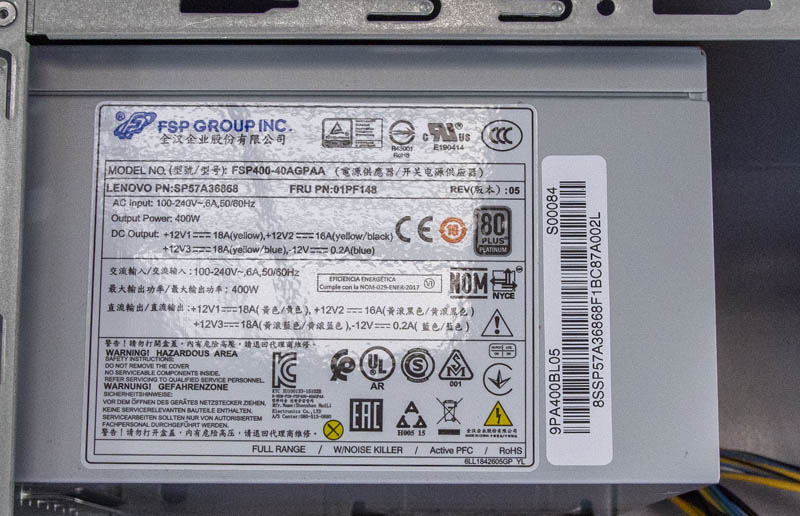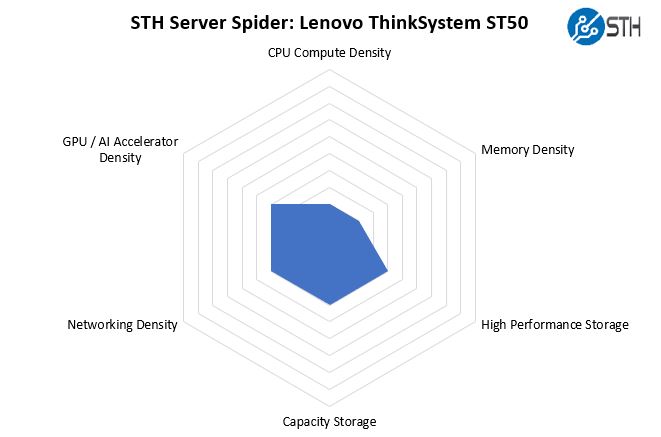Lenovo ThinkSystem ST50 Power Consumption
We used our Extech TrueRMS Power Analyzer 380803 to take measurements at different points of the Lenovo ThinkSystem ST50’s use on 120V power in the embedded lab. Tower servers tend to spend more time at the edge in offices rather than in higher power data centers, hence why we do our testing at lower voltage. Here are the figures:
- Power off: 3.9W
- Idle: 54.9W
- STH 70% Load: 146.3W
- STH 100% Load: 157W
- Max power observed: 184W
Here is a quick look at our 400W PSU. With the full set of drives, memory, expansion cards, and high-end CPUs the 400W unit is what we would recommend. It is also rated at 80Plus Platinum efficiency which is better than many PSUs in this segment.

Without the XCC controller or another form of external BMC, the “power off” numbers were best-in-class.
Lenovo ThinkSystem ST50 Noise
The Lenovo ThinkSystem ST50 is designed to be run in offices. We used our Extech 407764 sound level meter to take a few different measurements of the platform.
- Idle: 33.1 dBA
- STH 70% Load: 43.5 dBA
- 100% Load in Performance mode: 52.7 dBA
Lenovo has a few different BIOS settings for fan modes. You can hit F1 to get into the UEFI setup during boot, then the setting is called ICE Performance Mode. There one can find 2HD Cooling Mode, 4HD Cooling Mode, Performance Mode, and Full Speed. The Full Speed option we generally would not recommend unless this is going to be run outdoors in the summer. If your system is loud, we recommend looking at this setting.
STH Server Spider Lenovo ThinkSystem ST50
In the second half of 2018, we introduced the STH Server Spider as a quick reference to where a server system’s aptitude lies. Our goal is to start giving a quick visual depiction of the types of parameters that a server is targeted at.

Overall, the Lenovo ThinkSystem ST50 is designed for low-density edge deployments. At the same time, Lenovo did a great job balancing cost-optimization with expansion capabilities.
Final Words
Overall, the Lenovo ThinkSystem ST50 is the Intel Xeon E platform you would expect. It is designed to keep costs low and provide a platform that can fill many edge computing roles.
Two items we would have liked to have seen would be a low-cost XCC option so that enterprises buying for their branch offices can use a single management plane. It is hard to decrement a rating for this since the Lenovo ThinkSystem ST250 has XCC. We were testing that system simultaneously so our recommendation here is to move up the stack if you need the feature. Likewise, redundant power supplies would be nice, but in the deployment scenarios these are designed for there is generally a single power source.
Overall, Lenovo did a great job making the ThinkSystem ST50 highly configurable while still making trade-offs to keep costs down.




My company recently deployed one of these server for a client. We ran into an issue with memory compatibility, if the system detects any third party ram it will stop at a bios screen proclaiming “unqualified dimm detected” and wait indefinitely for the f2 key to be pressed.
I’m really curios when Lenovo/HP/Dell start to realize that there is a new kid on the CPU block made by AMD which may make their small/cheapest servers even more cheap and yet wipe the floor with intel competition. Come on, having Ryzen in this kind of box with ECC RAM would be something nice…
I’ve also just had the “Unqualified DIMM detected” message appear after reinstalling 3rd party RAM in the server.
It would appear this is now a “feature” on Lenovo servers. There isn’t a way of disabling it. You must use Lenovo’s memory or you get the F2 message on boot.
https://support.lenovo.com/gb/en/solutions/ht115052-unqualified-dimm-has-been-detected-lenovo-server-and-lenovo-thinksystem